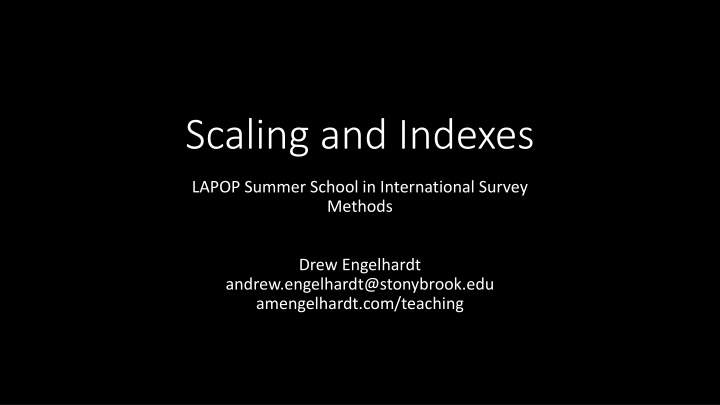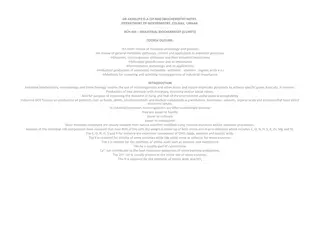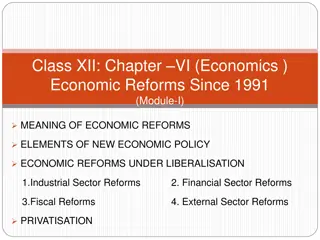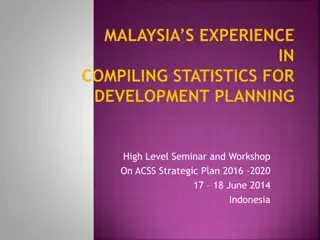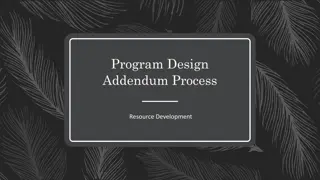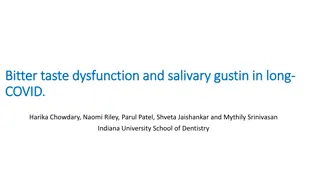CCR Industrial and Economic Plan Covid-19 Addendum May 2020
The Cardiff Capital Region's Industrial and Economic Plan underwent an addendum in May 2020 to address the challenges posed by the Covid-19 pandemic. The plan aims to adapt and respond dynamically while contributing towards a positive post-pandemic legacy. Recommendations include strategic responses to the pandemic, maintaining industry focus, and leveraging funding for business resilience and growth.
Download Presentation

Please find below an Image/Link to download the presentation.
The content on the website is provided AS IS for your information and personal use only. It may not be sold, licensed, or shared on other websites without obtaining consent from the author.If you encounter any issues during the download, it is possible that the publisher has removed the file from their server.
You are allowed to download the files provided on this website for personal or commercial use, subject to the condition that they are used lawfully. All files are the property of their respective owners.
The content on the website is provided AS IS for your information and personal use only. It may not be sold, licensed, or shared on other websites without obtaining consent from the author.
E N D
Presentation Transcript
Scaling and Indexes LAPOP Summer School in International Survey Methods Drew Engelhardt andrew.engelhardt@stonybrook.edu amengelhardt.com/teaching
Topics Why scaling? Process of Measurement Measurement Error Validating Scales Confirmatory factor analysis This afternoon: Factor analysis applications
First: Introductions Name What you do Motivation for attending the survey methods workshop
Topics Why scaling? Process of Measurement Measurement Error Validating Scales Confirmatory factor analysis This afternoon: Factor analysis applications
Process of measurement Conceptualization: define concept Operationalization: identify appropriate measure Validation: assess fit between measure and concept
Example: Measuring Nationalism Start with motivation: Greater levels of nationalism arguably underlie the founding of many nations (Anderson 1983) Ask what we should observe: Greater nationalism makes one pro- their nation and anti-other nations
First: conceptualization Nationalism: commitment to the denigration of alternatives to a nation s principles and institutions, which is reciprocally tied to chauvinism toward outsiders (deFiguieredo and Elkins 2003; Conover and Feldman 1987) If individuals vary, we want to make sure we capture these differences
Low Moderate Nationalism High
Second: operationalization The world would be a better place if people from other countries were more like Americans. 1. Strongly disagree 2. Disagree 3. Agree 4. Strongly agree
Low Nationalism High Nationalism Low Nationalism High Nationalism Low Nationalism High Nationalism High Nationalism Low Nationalism
Why care about variation? Accurately reflect reality Improve hypothesis testing (Bakker and Lelkes 2018)
Survey response reprise People have reasons for and against propositions People average across considerations salient at time of question, with salience defined by accessibility (chronic or temporary) People then map this constructed judgment onto available response options Explains: response instability, response effects Challenges: reported attitude depends on accessible considerations and response recording (Zaller and Feldman 1992; Tourangeau, Rips, and Ransinski 2000)
Second: operationalization The world would be a better place if people from other countries were more like Americans. Generally, the more influence America has on other nations, the better off they are. Generally speaking, America is no better than most countries. (reverse-scored) 1. Strongly disagree 2. Disagree 3. Agree 4. Strongly agree
Operationalization II: Creating Scales Sum together responses of relevant items But what if dissimilar response scales? Rescale to min-max (0-1) and sum Z-score and sum Z-score: subtract item average and divide by item standard deviation for each respondent But what if we want to assign weights to different items? Multiply by weight before summing (researcher-defined weights) Factor analysis (model-defined weights)
Plato: Early Survey Methodologist Data = Model + error Slippage between concept and operationalization Use scales and indexes to try and minimize error, but can never eliminate Allegory of the Cave
Measurement Error Random Error Systematic Error
Random Error Chance fluctuations which affect the measurement of some phenomenon (Carmines and Zeller 1980, 13) Can come from: Ambiguous instructions, enumerator response coding, question delivery, enumerator fatigue, survey context distractions Consequences: adds noise to recorded information Attenuates observed relationships Observed = True + error
Systematic Error Patterned (nonrandom) influences from third factor(s) affecting the measurement of some phenomenon Sources: Response sets (e.g., acquiescence) Interpersonal incomparability (e.g., feeling thermometer problem) Social desirability Consequences: over-/under-estimates of construct of interest or relationships between constructs if share error Biases observed relationships Observed = True + bias + error
Scales and Acquiescence Bias Respondent agrees to a survey question. Why? Also challenge for scales (unbalanced scales) Balanced scales Include equal shares of positively worded (PW) & negatively worded (NW) items NW alternatively termed reverse coded Average out ARS, but requires PW and NW items equally capture concept and acquiescence response style (ARS) Item-specific Ex. How important is it that vs. Do you agree or disagree that
Topics Why scaling? Process of Measurement Measurement Error Validating Scales Confirmatory factor analysis This afternoon: Factor analysis applications
Validating Scales Measurement reliability Measurement validity
Measurement Reliability Extent to which scores measured at one time and place with one instrument predict scores at another time and/or place and perhaps measured with a different instrument (Revell and Condon 2019, 1396) But also: consistency of measurement across items Are items capturing a homogenous construct? What s the signal-to-noise ratio of our scale?
Factors Affecting Measurement Reliability Random measurement error Scale length
Evaluating Measurement Reliability Average/median inter-item correlation; item-total correlations Split-half correlations: explore distribution of all possible divisions of items Cronbach s : proportion of variance in a scale attributable to a common source ? = scale variance ? 1 Most common, but has issues given strong assumptions (see: McNeish 2018) McDonald s : proportion common variance like , but with relaxed assumptions Model-based estimate rather than algebraic calculation Note: most estimates of reliability like and trend toward 1 as the number of items increases scale variance item variance ?
Measurement Validity Does a variable measure what it is supposed to measure. Observed scores on an item interpreted as capturing intended (latent) concept. (Bollen 1989, 184) Types (Adcock and Collier 2001) Content: degree to which indicator fully represents concept of interest Does our scale have items covering its full definition? Discriminant: degree to which alternative indicators of same concept correlate Does our scale relate to other established measures of the same concept? Nomological/construct: degree to which established causal hypotheses again find support when using new measure Does our scale replicate existing findings?
Factors Affecting Measurement Validity Systematic measurement error Question wording
Evaluating Measurement Validity Via correlations Discriminant: compare summed scale with other measures of same concept Nomological: compare summed scale to other theoretically relevant measures Via Confirmatory Factor Analysis Test hypothesis about model-data fit given relationships among scale items and between (un)related constructs
Topics Why scaling? Process of Measurement Measurement Error Validating Scales Confirmatory factor analysis This afternoon: Factor analysis applications
Confirmatory Factor Analysis (CFA) Measurement model relating observed items to unobserved factors Hypothesis: some latent construct exists which causes the correlations we observe between items Recall: nationalism CFA lets us test this hypothesis. Does the model we propose (e.g., a 3- item set captures a single concept) fit the data?
Concept Item 2 Item 1 Item 3 1 2 3
Concept ? Item 2 Item 1 Item 3 Item 4 1 2 3 4
? Concept Concept Item 1 Item 2 Item 5 Item 6 Item 3 Item 4 Item 7 Item 8 1 5 2 3 6 7 4 8
Concept ( 1) ?1 ?4 ?2 ?3 Item 2 Item 1 Item 3 Item 4 1 2 3 4
CFA Foundation: Common Factor Model Observed (measured) items are a linear function of one or more common factors and a unique factor Items have shared (common) variance & unique variance which FA separates Common variance: seen in correlations among items Unique variance: reliable, indicator-specific variance and measurement error
CFA as linear regression Concepts cause item responses, and we can parameterize these relationships ??= ?? 1+ ? ??: observed response to item j 1: individual score on factor 1 Common variance ??: factor loading (e.g., regression slope) ?: unique variance Hypothesis testing about parameters proceeds as typical
CFA as linear regression Observed items need not be related to only one construct Multiple sources of common variation for an item Akin to multiple regression One dimensional model: ??= ?? 1+ ? m-dimensional model: ??= ?? 1+ ?? 2+ + ?? ?+ ?
Concept Concept Item 1 Item 2 Item 5 Item 6 Item 3 Item 4 Item 7 Item 8 1 5 2 3 6 7 4 8
Identification and Estimation CFA has many freely estimated parameters, requiring a model identification strategy Need: Scale for the latent variable Sufficient information for statistical identification
Identification and Estimation Scaling the latent variable (what are its units?) Option 1: fix the latent variable s metric to that of one of its indicators Factor loadings sized relative to this marker indicator One-unit change in LV defined by this item s units Option 2: fix the latent variable s variance Usually 1 for standardization Factor loadings now in standard deviation units
Identification and Estimation Statistical identification depends on freely estimated parameters and knowns Knowns: item information (usually item variances and covariances) Unknowns: factor loadings, error (co)variances
Identification and Estimation CFAs typically estimated via Maximum Likelihood Find combination of parameters which make observed data most likely
Model Fit How well does the model-predicted variance-covariance matrix reflect the sample variance-covariance matrix? Perfect fit: ?2(classic, but used less in applied settings) Does the predicted VCOV perfectly captured the sample VCOV? Absolute fit: Standardized root mean square residual (SRMR) Average difference between observed and predicted correlations among variables Parsimony correction: Root mean square error of approximation (RMSEA) Given ?2 and degrees of freedom (DF), does model fit reasonably well in population? Comparative fit: comparative fit index (CFI) How well does the model fit relative to null model where all item correlations are 0?
Model Fit Interpretation Guidelines Consider information from multiple fit indices ?2: p > 0.05, cannot reject null that model fits data perfectly SRMR: 0-1, values nearer 0 indicate small residuals Values < .08 typically seen as good RMSEA: 0-1; typically reported with 90% confidence intervals Values < .06 good; >.08 and < .10 mediocre; >.10 bad Use confidence interval and estimate to think about range of possible model quality CFI: 0-1; higher values denote closer correspondence between model and data Values > .90 seen as acceptable, >.95 good Note: thresholds for SRMR, RMSEA, and CFI based on simulation studies and are guidelines only. Ongoing debate about what exactly indicates good fit among methodologists
Why care about model fit? Model establishes global hypothesis about relationships among items. We want to make sure data support this hypothesis. Applications: Is my proposed scale valid (e.g., unidimensional)? Are the relationships between items consistent with one hypothetical reason and inconsistent with another? Consider: ?2 significant? Do SRMR, RMSEA, and CFI indicate good or poor fit? Challenge: notions of good fit or meaningful change in fit are subjective
Interpreting CFA Models Pay attention to factor loadings: larger are better Pay attention to model fit: does hypothesized model fit the data well
Application: Feldman and Huddy (2010) The Structure of White Racial Attitudes Investigations of White racial prejudice (specifically anti-Black racism) are fractured, using myriad measures. Are attitudes as varied as these measures or are there common features? Example measures: stereotypes, explanations for inequality, racial resentment, feeling thermometers Propose tripartite structure Overt racism (innate differences) Denial of discrimination Motivation and values
Communality: share of variance in an item attributable to common factors .19 = 19% of the variance in hardworking/lazy stereotyping comes from the 3 factors here. (Feldman and Huddy 2010)
CFA and Error Structures Items correlated because of common variance which defines our factor Common variance: substantive, but also method But we want only substantive in our scale, so what can we do? Model these errors! Goal: focus attention to substantive variance by specifying a model more accurately characterizing the world Specify a correlation between errors: items covary for reasons unrelated to shared influence of the common factor
